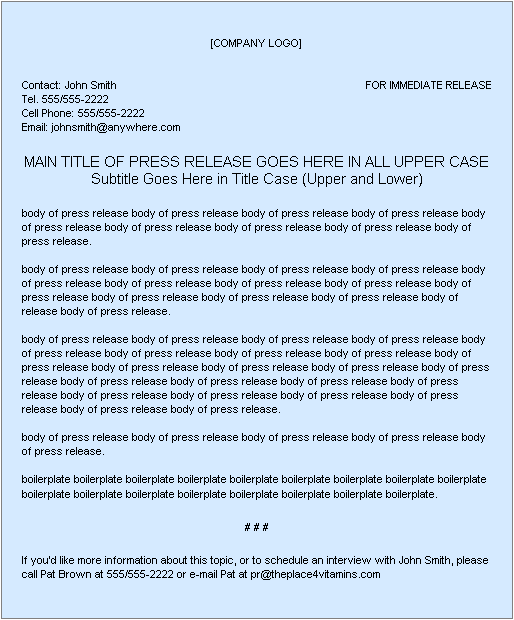When you hear the term, you might get the impression that this form of media exposure is intended only for the “real” businesses out there and people like you should stick to the YellowPages. The reason for this thinking stems from the fact that people mistake press releases for sales pitches. In reality, a press release is a form of newspaper advertising used to generate buzz around your business and/or product.
A press release can be a sales pitch, but you don’t want it to sound or look like one. The idea is to  give an editor something to write about. Newspapers couldn’t exist without news and they’re reporters don’t always get the stories because they happened to be caught in the middle of it. So, let’s bring the story to them!
give an editor something to write about. Newspapers couldn’t exist without news and they’re reporters don’t always get the stories because they happened to be caught in the middle of it. So, let’s bring the story to them!
This guide will focus on HOW to write a press release. Finding out where to send it varies greatly on who you’re sending it to. Generally speaking, you can send a press release alone as nothing more than a one-page writing or you can go all out and develop a full press kit. More on this later. Right now, let’s get into the creation of your first press release.
The easiest way to do this is to break apart a standard press release template and focus on each section. A standard template I recently found online looks like this:

Top Section/Headline
The very top is self-explanatory as you can see. Simply start with some professional letterhead for your company or website and begin thinking of your headline. This headline should be written just like you see in a newspaper and should grab your attention just like it too. Keep it short and concise. Again, remember that you don’t want to come off as promoting your business. Use the headline to offer the best part(s) of your story. Pretend that you know the editor is only going to read the headline. He/she needs to know right from the start what this release is going to be about. Formatting tip: the headline should be in all capitals.
For our example, we’ll be writing a press release for a webhosting company. As we go along, I’ll show you a good and bad example for each section.
A bad headline:
NEW HOSTING COMPANY SERVEROCITY.COM OFFERS UNLIMITED BANDWIDTH TO PROVIDE BETTER SERVICE FOR ONLINE BUSINESSES AND BEAT OUT COMPETITION
A good headline:
ONLINE BUSINESSES: NEW WEBHOST TO OFFER UNLIMTED BANDWIDTH
Body – Introduction
This section is known as the lead paragraph and its goal is to provide a more detailed description than the headline can offer. This paragraph should condense the entire story into an “introduction-style” format that enables the editor to gain a firm grasp on what’s about to be told. Use this section to speak the facts and stay far away from lies, exaggerations and sales pitches.
A bad lead:
A new webhost named Serverocity.com, which offers the lowest priced webhosting plans anywhere and is regarded as a top webhost has just announced that they will be offering no bandwidth limits on their already extremely valuable webhosting plans.
A good lead:
The Internet is a changing forum. Today, websites are packed with more and more content-rich media such as music, videos, Flash and web applications. While the Internet has evolved, hosting providers have not. Anyone who operates a website knows how expensive it can be if their website goes over its bandwidth limit. To top it off, these sites can be shutdown for the remainder of the month until the counter is reset. A new hosting provider seeks to change this. Serverocity.com has recently announced their plans for providing webmasters worldwide with no bandwidth limits every webhosting plan. According to John Smith, the CEO of Serverocity.com, web hosts need to wake up and realize that limited accounts will no longer “fly” in this new wave of Internet technology.
Body – Bulk
The rest of the body is used to reiterate the text you wrote in the lead paragraph. This is where you dive into all the little details of your story. Use quotes from people that express a concern that your business is addressing and/or quote other articles that can also relate to your claims. Ideally, you want to provide credible backup to your claim. Of course you still want to remain concise, so don’t overdo the quotes or you may not sound legitimate. If you’re offering particular services, try not to make this section look like a flyer, but if you can integrate the information with related sentences, you can get away with it.
For example:
…and Joe, from Cnet.com says, “I can’t believe the amount of overages I pay every month!”. Serverocity has gotten fed up with webmasters that share the same sentiment. Because their plans have no “overages”, nobody feels gouged.
In the above example, I was able to make a specific claim about my business’ service, but you can see how well it fits into the previous quote.
Boilerplate
‘boilerplate’ is an old term that defines a block of text that is continually used over and over. It referred to an unchangeable section of text that could be used on printing presses. Right after the body, you are now free to discuss more clearly what the business is with details such as when did you first open, who founded it and what the overall purpose is. This, again is not a sales pitch–it’s simply a short paragraph that talks about the business.
Bad boilerplate:
Serverocity.com – the world’s leader in webhosting services. We offer 5 hosting plans to choose from that will fit well in anyone’s budget! Stop by our website today or give us a call now. We can work with you on any number of specific addons or needs that you require.
Good boilerplate:
Serverocity.com was founded by John Smith in 1998 and is home to thousands of websites. Serverocity also offers free web design tips, how-to guides and industry news through its website and monthly newsletters.
After the # # #
The three hash symbols simply means “no more copy”. In other words, anything written after this line is not part of the release and should not be considered part of any reporting done with this document. After this line, you would want to put some personal information like:
To receive more information on this subject, please contact John Smith at: 555-555-5555 or to request an interview, please contact press@serverocity.com
That’s it! You’ve just created your first press release. So what should you do with it? Start sending it to your local newspapers or if you can offer a service nationwide, send it everywhere you can. It costs nothing more than postage to send these out, so as many as you can get to, the better. Of course there’s no guarantee that anything will get printed, but that’s ok. If you do get printed and your business benefits from it, then you just got more customers and didn’t have to pay much for them!